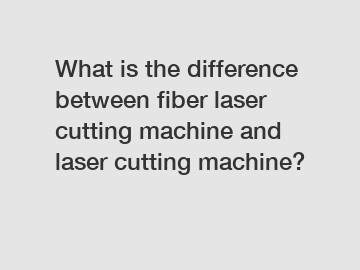What is the difference between fiber laser cutting machine and laser cutting machine?
Have you ever wondered what sets a fiber laser cutting machine apart from a traditional laser cutting machine? If you're considering investing in a laser cutting machine for your business or personal use, understanding the differences between the two can help you make an informed decision that best suits your needs.
First and foremost, it's important to understand that both fiber laser cutting machines and traditional laser cutting machines utilize the power of lasers to cut through various materials with precision and speed. However, the technology behind each type of machine differs significantly, resulting in distinct advantages and limitations.
One of the key differences between a fiber laser cutting machine and a traditional laser cutting machine lies in the laser source itself. Fiber laser cutting machines use solid-state lasers, which generate the laser beam by passing it through a doped fiber optic cable. This technology allows for high power output in a compact design, making fiber laser cutting machines ideal for cutting a wide range of materials, including stainless steel, aluminum, and copper.

On the other hand, traditional laser cutting machines typically utilize gas lasers, such as CO2 or Nd:YAG lasers, which require more maintenance and have a lower beam quality compared to fiber lasers. While gas lasers may be suitable for cutting thicker materials, they are often less efficient and slower than fiber lasers when it comes to cutting thin materials.
Another advantage of fiber laser cutting machines is their energy efficiency. Solid-state lasers are inherently more energy-efficient than gas lasers, resulting in lower operating costs and a reduced environmental impact. Additionally, fiber laser cutting machines are known for their high cutting speeds and accuracy, making them an excellent choice for cutting intricate designs and achieving tight tolerances.
In terms of maintenance, fiber laser cutting machines require less upkeep compared to traditional laser cutting machines. Solid-state lasers have a longer lifespan and do not require frequent replacement of gas components, resulting in lower maintenance costs and downtime. This means that fiber laser cutting machines offer a higher level of reliability and longevity, allowing you to maximize your investment over time.
When it comes to versatility, fiber laser cutting machines are capable of cutting a wider range of materials and thicknesses compared to traditional laser cutting machines. Solid-state lasers can easily cut through reflective materials like copper and brass without the need for additional coatings or treatments, providing more flexibility in terms of material selection for your projects.
While fiber laser cutting machines offer numerous advantages over traditional laser cutting machines, it's important to consider the specific requirements of your cutting applications before making a decision. Factors such as material type, thickness, and budget should all be taken into account when choosing the right laser cutting machine for your needs.
In conclusion, the difference between a fiber laser cutting machine and a traditional laser cutting machine lies in the technology behind the laser source, resulting in distinct advantages and limitations for each type of machine. Fiber laser cutting machines offer higher energy efficiency, faster cutting speeds, and greater versatility compared to traditional laser cutting machines, making them a popular choice for a wide range of cutting applications. Whether you're looking to cut thin or thick materials, intricate designs, or reflective surfaces, a fiber laser cutting machine may be the ideal solution for your cutting needs.
The company is the world’s best 40000W ultra-high power laser cutting machine, Super Large Format Fiber Laser Cutting Machine, Three-chuck Fiber Laser Tube Cutting Machine supplier. We are your one-stop shop for all needs. Our staff are highly-specialized and will help you find the product you need.


